June 5, 2025
Understanding Rust’s Memory Management
Rust's approach to memory management is both powerful and nuanced. In this article, we’ll take a deep dive into how Rust handles memory at the level of its type system. Along the way, we’ll answer key questions such as:
- Why can’t we create purely dynamic types in Rust?
- How does the Rust compiler determine where and how to allocate memory for variables?
- What exactly does a pointer inside a fat pointer refer to—especially in the case of string literals?
- What role does
libcplay in all of this?
Key Definitions
ZST (Zero-Sized Types)
A type that has no size at compile time. The entire size of this type is "collapsed" to zero during compilation.
Note: ZSTs always implement the Sized trait.
Example:
struct Marker;
DST (Dynamically Sized Types)
Non-sized types (!Sized) whose length information isn’t encoded in the type itself. Their size is determined at runtime and stored as metadata associated with a pointer.
Examples:
str[T]dyn Trait
DSTs must always be used behind pointers that carry additional metadata, such as:
&str&[T]Box<[T]>Rc<dyn Trait>
Machine Word (word)
The amount of data a CPU can process in one unit of time. The addressable memory space is determined by the machine word size of the CPU. For example, on a 64-bit processor, the word size is 64 bits (8 bytes).
Important Note:
In Rust, the size of a pointer (usize) is equal to the size of a machine word. This applies to fields like:
ptr(pointer to data)cap(capacity, e.g., inVec)len(length, e.g., inStringor slices)
1. Basic Concepts of Memory Management
Once Rust code is compiled into an executable, the resulting binary file contains data, metadata, and machine instructions tailored for the target CPU architecture. This binary uses platform-specific formats such as:
- ELF (Executable and Linkable Format) on Linux
- PE (Portable Executable) on Windows
- Mach-O (Mach Object) on macOS
Regardless of the specific format, the execution mechanism remains largely the same across platforms.
Program Execution and Virtual Address Space
When a program (or process) is launched, the operating system kernel reads the segment metadata from the binary—such as .text (code), .data (initialized data), and .bss (uninitialized data)—and allocates the necessary memory based on this information.
This allocated memory forms the virtual address space of the process—a contiguous range of memory addresses that the process perceives as its own, from address 0 to the maximum available address.
📌 From the process’s perspective, it sees a flat, continuous block of memory—even though the actual physical RAM may be fragmented or only partially allocated.
Lazy Allocation and Physical Mapping
Memory allocation is done lazily, meaning that although virtual memory is reserved upfront, the mapping to real physical memory occurs only when the memory is first accessed. This mapping is handled by a combination of:
- The kernel, which manages virtual memory regions
- The Memory Management Unit (MMU), a hardware component responsible for translating virtual addresses to physical ones
At startup, the kernel maps the relevant segments (like .text, .data) into the process's virtual address space. The exact number and size of these segments depend on how the compiler structured the binary.
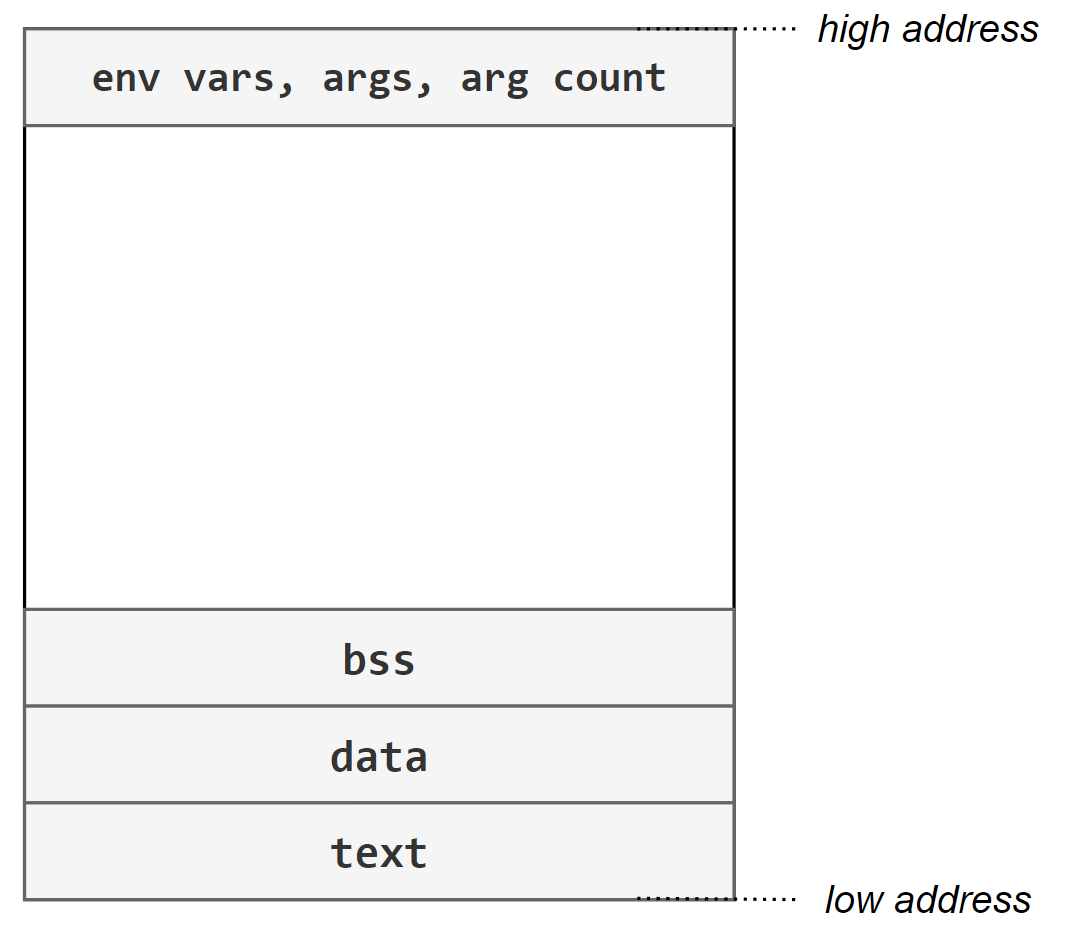
Understanding Segment Metadata in an Executable
Below is an example of how memory sections are laid out in a compiled binary:
| Section | Size | Address |
|------------------|-------|---------------|
| `.vector_table` | 192 | `0x10000100` |
| `.text` | 33044 | `0x100001d4` |
| `.rodata` | 4904 | `0x100082e8` |
| `.data` | 0 | `0x20000000` |
| `.bss` | 4 | `0x20000000` |
| ... | | |
Each of these sections plays a specific role in the execution and memory layout of a Rust program. Let’s take a closer look at the most important ones.
.text
This section contains the compiled machine instructions (the executable code) of your program.
- It is loaded into memory with Read + Execute permissions.
- The running program cannot modify this section—ensuring that the code remains constant during execution.
- These instructions are architecture-specific, meaning they depend on the target processor (e.g., x86_64, ARM). As a result, binaries cannot be automatically ported between platforms without recompilation.
.data
This section holds initialized global and static variables—that is, variables that have been assigned a value at compile time.
Example:
static MY_VAR: i32 = 42;
These values are stored directly in the binary and are loaded into memory when the program starts.
.bss (Block Started by Symbol)
The .bss section stores uninitialized global and static variables.
- These variables are not stored in the binary file itself but are allocated space at runtime.
- The operating system guarantees that all
.bssvariables are initialized to zero before themainfunction runs.
Example:
static mut UNINIT_VAR: i32 = 0; // Actually goes into .bss if uninitialized
⚠️ Note: In Rust, you typically avoid direct use of
.bssthrough safe code, but it's still used internally for certain kinds of static variables.
The Stack
The stack is a region of memory located at the top of the user space and grows downward in memory (toward lower addresses).
Key Characteristics:
- Each thread has its own private stack.
- On 64-bit Linux systems, Rust programs allocate an 8MB stack for the main thread by default.
- For other threads, the default stack size is typically 2MB, although this can be customized using the Rust standard library.
use std::thread;
thread::Builder::new()
.stack_size(4 * 1024 * 1024) // 4MB stack size
.spawn(|| {
// thread logic here
});
Lazy Allocation
Although the main thread is assigned an 8MB stack:
⚠️ This memory is not allocated all at once.
Instead, it follows a lazy allocation strategy — only the initially accessed pages are mapped into physical memory by the kernel.
This means that if your program doesn’t use the full stack, not all of the memory is actually used in RAM.
Stack Growth Direction
- The stack grows downward — from higher memory addresses to lower ones.
- It can expand until it reaches the configured maximum stack size for that thread.
If a thread attempts to use more stack space than allowed:
💥 A stack overflow occurs, and the kernel terminates the thread (and often the whole program), usually with a segmentation fault or similar error.
The Heap
The heap is a region of memory used for dynamic memory allocation and is shared among all threads in a process.
Key Characteristics:
- Memory addresses on the heap start close to zero, right after the
.text,.data, and.bsssections. - Unlike the stack, the heap grows upward — toward higher memory addresses.
Size and Scalability
- The heap can grow to very large sizes, limited mostly by system resources and virtual address space constraints.
- On 64-bit systems, the theoretical upper limit is up to 128 terabytes (or more, depending on the OS and architecture).
This flexibility makes the heap ideal for allocating data whose size isn't known at compile time — such as Vec<T>, String, or boxed types like Box<T>.

How Rust Uses the Stack
The stack plays a crucial role in Rust’s execution model. Its primary purpose is to store data for the currently executing function — including:
- Function parameters
- Local variables
- The return address (where execution should continue after the function finishes)
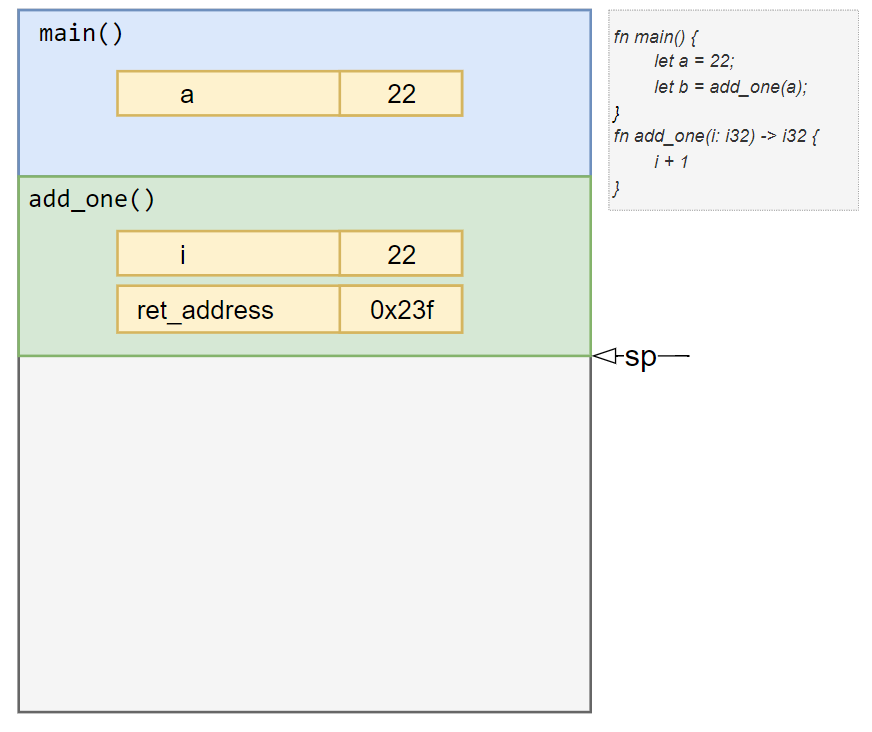
What Can Go on the Stack?
Only variables with a fixed, known size at compile time can be placed directly on the stack.
This includes:
- Primitive types like
i32,bool,char - Fixed-size arrays like
[u8; 16] - Structs composed of stack-allocatable fields
Types with dynamic or unknown size (like str, [T], or trait objects) must be accessed via pointers (e.g., &str, Box<[T]>).
Understanding Stack Frames and the Stack Pointer
Stack Frame
A stack frame is the block of memory allocated for the execution of a single function. It contains:
- The function’s local variables
- Parameters passed to the function
- The return address — where execution should resume after the function completes
Stack Pointer
The stack pointer is a CPU register that keeps track of the current top of the stack.
- When a function is called: the stack pointer is increased (or decreased, depending on architecture) to allocate space for the new stack frame.
- When a function returns: the stack pointer is moved back, effectively deallocating the frame.
✅ Because this is just a simple pointer adjustment, allocation and deallocation on the stack are extremely fast — no system calls are needed.
Example Execution Flow
Let’s walk through how stack frames are created during function calls:
-
A stack frame is first created for the
main()function.- All local variables with known sizes are stored here.
-
main()calls another function, sayadd_one().- A new stack frame is created for
add_one(), large enough to hold its local data.
- A new stack frame is created for
-
The return address, e.g.,
0x23f, points to the next instruction inmain()— typically the line after the function call (e.g.,let b = add_one(a);).- This tells the CPU where to continue execution once
add_one()finishes.
- This tells the CPU where to continue execution once
-
After
add_one()returns:- The stack pointer is adjusted back to the previous frame (for
main()). - The memory used by
add_one()'s stack frame isn’t immediately cleared — it will simply be overwritten when the next function is called.
- The stack pointer is adjusted back to the previous frame (for
📌 This lazy cleanup is part of what makes stack operations so efficient.
How Rust Uses the Heap
In Rust, heap memory allocation is managed through the GlobalAlloc trait — a core abstraction that defines the functions an allocator must implement.
By default, Rust uses the malloc function from the standard C library (libc) to manage dynamic memory. This means:
⚠️ Rust assumes the presence of
libcon the target platform for standard heap allocations.
Why Heap Allocation Is Slower
Allocating and managing memory on the heap is generally slower than stack operations, mainly due to:
- System calls made to
libcfor requesting or releasing memory. - The allocator's internal search for a suitable block of memory that fits the requested size.
To minimize performance overhead and reduce the number of system calls, modern allocators often:
🔄 Request memory in larger blocks and manage them internally, reusing chunks as needed.
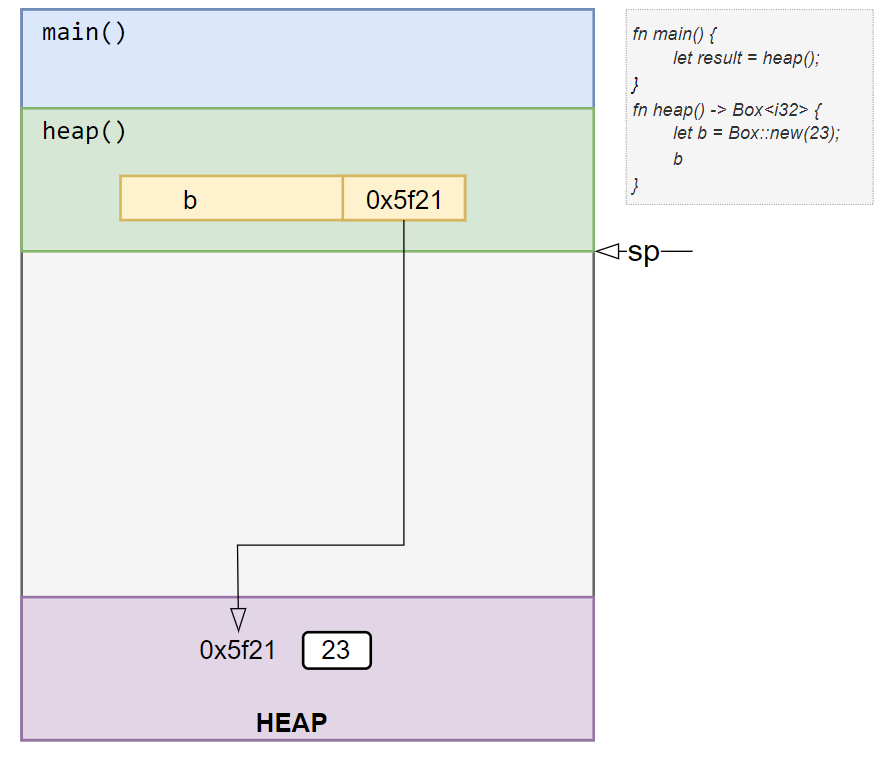
Heap Allocation in Practice
Let’s walk through a simple example using Box<T>:
- The main stack frame is created for the
main()function. - A nested stack frame is created when calling a helper function like
heap().
Inside heap():
- A
Box<i32>is created with the value23. - Since
i32takes 4 bytes, space for it is allocated on the heap. - A pointer to this memory (e.g., address
0x5f21) is stored in the variablebon the stack. - Because pointers have a fixed size (
usize, which is 8 bytes on 64-bit systems),bcan safely live on the stack.
When heap() returns:
- The pointer to the boxed value is passed back to
main()via the return address (e.g.,0x5f21). - Even though the stack frame of
heap()is deallocated, the data on the heap remains intact. - The
resultvariable inmain()now holds the pointer to that heap-allocated data.
✅ This is what makes heap-allocated data long-lived — it persists beyond the scope of the function that created it, until explicitly dropped or goes out of scope in Rust.
Rust Data Types:
Integers
In Rust, integer types are fundamental data types that are stored entirely on the stack, making them fast and efficient to work with.

Signed vs. Unsigned
Rust supports both signed and unsigned integers:
- Signed (
i): Can represent both positive and negative numbers. - Unsigned (
u): Only non-negative numbers (0 and positive).
Each type indicates how many bits it uses in memory.
| Type | Size | Description |
|--------------|-----------|-------------------------------------|
| `i8` / `u8` | 1 byte | 8-bit signed/unsigned integer |
| `i16` / `u16`| 2 bytes | 16-bit signed/unsigned integer |
| `i32` / `u32`| 4 bytes | 32-bit signed/unsigned integer |
| `i64` / `u64`| 8 bytes | 64-bit signed/unsigned integer |
| `i128` / `u128` | 16 bytes | 128-bit signed/unsigned integer |
Floating Point Numbers
Although not integers, floating-point types are also stack-allocated and included here for completeness:
| Type | Size | Description |
|----------|-------------|---------------------------|
| `f32` | 4 bytes | 32-bit IEEE 754 float |
| `f64` | 8 bytes | 64-bit IEEE 754 float |
Pointer-Sized Types
These types vary in size depending on the target architecture:
| Type | Size on 32-bit | Size on 64-bit | Use Case |
|--------------|----------------|----------------|---------------------------------|
| `isize` | 4 bytes | 8 bytes | Signed index/size values |
| `usize` | 4 bytes | 8 bytes | Unsigned index/size values |
📌 These types are especially useful when working with memory addresses or collections like
Vec<T>where indexing and length tracking are needed.
char
The char type in Rust is a primitive data type that represents a single Unicode Scalar Value.
Key Features:
- It always takes up a fixed size of 4 bytes (32 bits) in memory.
- Like other primitive types such as
i32,u8, andbool, it is stored on the stack by default. - It supports any valid Unicode character, including:
- Basic ASCII characters (
a,Z,0, etc.) - Special symbols (
€,©,®) - Emojis (
🦀,🔥,🌍)
- Basic ASCII characters (
Fixed Size, Universal Representation
Regardless of the complexity or visual representation of the character, every char in Rust uses exactly 4 bytes of memory.
This ensures consistent and efficient handling of text at the lowest level, making operations like indexing and storage predictable and fast.
📌 Example:
'a','€', and'🦀'all occupy 4 bytes in memory when stored as achar.
Tuples
A tuple is a composite type that consists of a fixed set of values, potentially of different types.
Storage and Memory Layout
- If all the individual elements of a tuple can be stored on the stack, then the entire tuple is also stored on the stack.
- The total size of a tuple isn't just the sum of its fields' sizes — it also includes padding for alignment to ensure efficient access by the CPU.

Understanding Alignment
Rust (and most systems) align data in memory to allow the CPU to read it more efficiently. This means:
📏 The compiler inserts padding bytes between fields so that each field starts at a memory address that is a multiple of its alignment requirement.
Example:
Consider the tuple (char, u8, i32):
| Type | Size (bytes) |
|---------|--------------|
| `char` | 4 |
| `u8` | 1 |
| `i32` | 4 |
Sum of sizes:
4 + 1 + 4 = 9 bytes
But due to alignment rules:
- After
char(4 bytes),u8takes 1 byte, followed by 3 padding bytes to align the next field (i32) to a 4-byte boundary. - Total size becomes 12 bytes.
Calculating Aligned Size
Let’s break down how the aligned size is calculated:
- Sum of raw sizes: 9 bytes
- Alignment denominator (most strict alignment in the tuple): 4 bytes
- Unaligned blocks:
9 / 4 = 2.25→ round up to 3 - Aligned size:
4 * 3 = 12 bytes
std::mem::size_of::<(char, u8, i32)>(); // returns 12
std::mem::align_of::<(char, u8, i32)>(); // returns 4
This ensures that each field is properly aligned in memory, improving performance and preventing hardware faults on some architectures.
References
In Rust, references allow you to refer to a value without taking ownership of it. They are a core feature of the language and are stored on the stack by default.
&T – Shared Reference
- A shared reference (
&T) contains the memory address of the original variable it points to. - It is represented internally as a single pointer (a single machine word).
- Stored entirely on the stack, unless part of a struct or type that lives on the heap.
let x = 42;
let r = &x; // r is a shared reference to x
📌 Size of
&Tis equal tousize— typically 8 bytes on 64-bit systems.
&&T – Reference to a Reference
- A reference to a reference (
&&T) is still just a pointer to another pointer. - Also takes up exactly 1 machine word (again, usually 8 bytes).
- No extra metadata — just a direct pointer indirection.
let x = 42;
let r1 = &x;
let r2 = &r1; // r2 is a reference to a reference
&mut T – Mutable Reference
- A mutable reference (
&mut T) has the exact same memory layout as a shared reference (&T). - Still just a pointer — also takes 1 machine word.
- The difference between
&Tand&mut Tlies in semantics and borrow checking, not in how they are represented in memory.
let mut x = 42;
let m = &mut x; // m is a unique mutable reference to x
⚠️ While the layout is the same, Rust enforces strict rules at compile time:
- Only one mutable reference can exist to a piece of data in a particular scope.
- No other references (mutable or shared) can coexist with an active mutable reference.
Arrays
In Rust, an array is a fixed-size collection of elements, all of the same type.
Declaration Example:
let a: [i32; 3] = [55, 66, 77];
Key Characteristics:
- ✅ Fixed Size: The size of an array is known at compile time and cannot change after creation.
- 🔄 Size is Part of the Type:
[i32; 3]and[i32; 4]are considered different types. - 🧱 Homogeneous Elements: All values in an array must be of the same type.
- 📦 Stack Allocated: Arrays are stored directly on the stack, with each element placed immediately after the previous one in memory.
This makes arrays very efficient for use cases where the number of elements is known ahead of time and doesn’t need to grow or shrink.
📌 Because arrays have a fixed layout and known size, they are ideal for low-level systems programming and performance-sensitive code.
Vector
In Rust, Vec<T> is a growable, heap-allocated list type that provides a dynamic alternative to fixed-size arrays.
Declaration Example:
let v: Vec<i32> = vec![55, 66, 77];
Key Features:
- ✅ Dynamic Size: Unlike arrays, vectors can grow or shrink at runtime.
- 🔄 Homogeneous Elements: All elements must be of the same type
T. - 📦 Heap Allocated Data: The actual data lives on the heap, while the vector itself (the control block) is stored on the stack.
Memory Layout
A Vec<T> stores three values on the stack:
| Field | Description |
|-------|-------------|
| `ptr` | A pointer to the start of the allocated memory block on the heap. |
| `len` | The number of elements currently in the vector. |
| `cap` | The total number of elements the vector can hold before needing to reallocate. |
This makes Vec<T> a fat pointer — it contains more than just an address.
How Reallocation Works
When the length (len) reaches the capacity (cap) and you try to add another element:
- 🧱 The vector allocates a new, larger block of memory on the heap.
- 📋 It copies all existing elements from the old block to the new one.
- 🔁 Updates its internal pointers to reference the new memory location.
- 🗑️ The old block is then deallocated (freed).
⚠️ Reallocation is relatively expensive, so it’s often optimized by increasing capacity exponentially (e.g., doubling it), reducing how often it happens.
Slices
In Rust, a slice ([T]) is a view into a contiguous sequence of elements in memory. It is similar to a fixed-size array, but with one key difference:
🔄 The size doesn’t need to be known at compile time and is instead determined at runtime.
Declaration Example:
let a: [i32; 3] = [55, 66, 77];
let v: Vec<i32> = vec![55, 66, 77];
let s1: &[i32] = &a[0..2]; // slice of the array
let s2: &[i32] = &v[0..2]; // slice of the vector
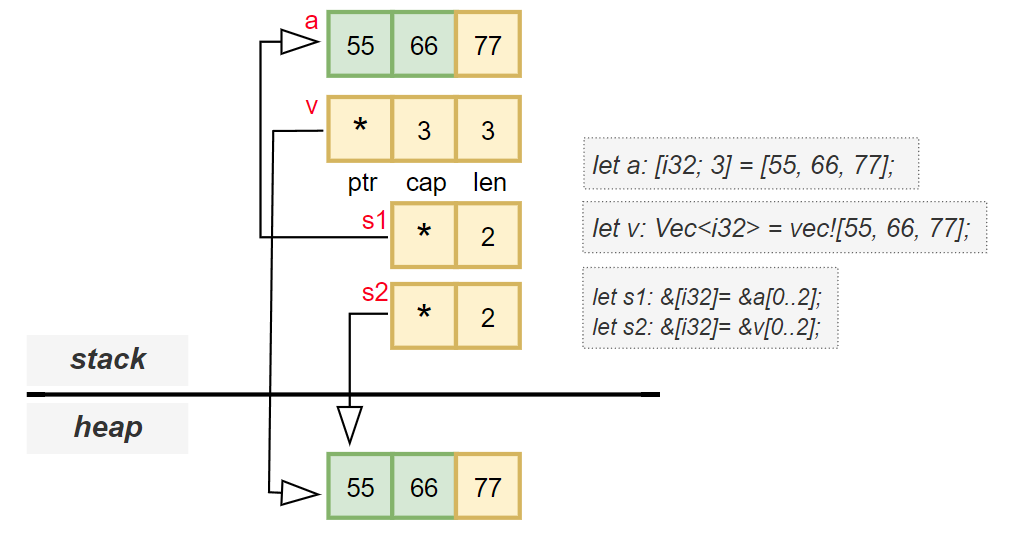
These slices give you a way to refer to a portion of the data without taking ownership.
Memory Representation
Slices themselves are not directly usable — they must be accessed through a reference, such as &[T]. This reference is what’s called a fat pointer, which contains two pieces of information:
| Part | Description |
|--------|-------------|
| `ptr` | A pointer to the first element in the slice (`*const T`) |
| `len` | The number of elements in the slice (`usize`) |
This means that while the type [T] itself does not carry length information, the reference to it (&[T]) does.
✅ So even though
[T]is a dynamically sized type (DST), using it behind a reference like&[T]makes it usable by attaching metadata (length) to the pointer.
Why Slices Are Powerful
- 🔍 They provide a safe and efficient way to work with a subset of a collection.
- 🧱 You can create slices from arrays, vectors, or even other slices.
- ⚡ Since slices are just pointers + length, they're very lightweight and fast to pass around.
Strings — String, str, and &str
In Rust, strings are a core part of the language but come in different forms, each with its own purpose and memory behavior.
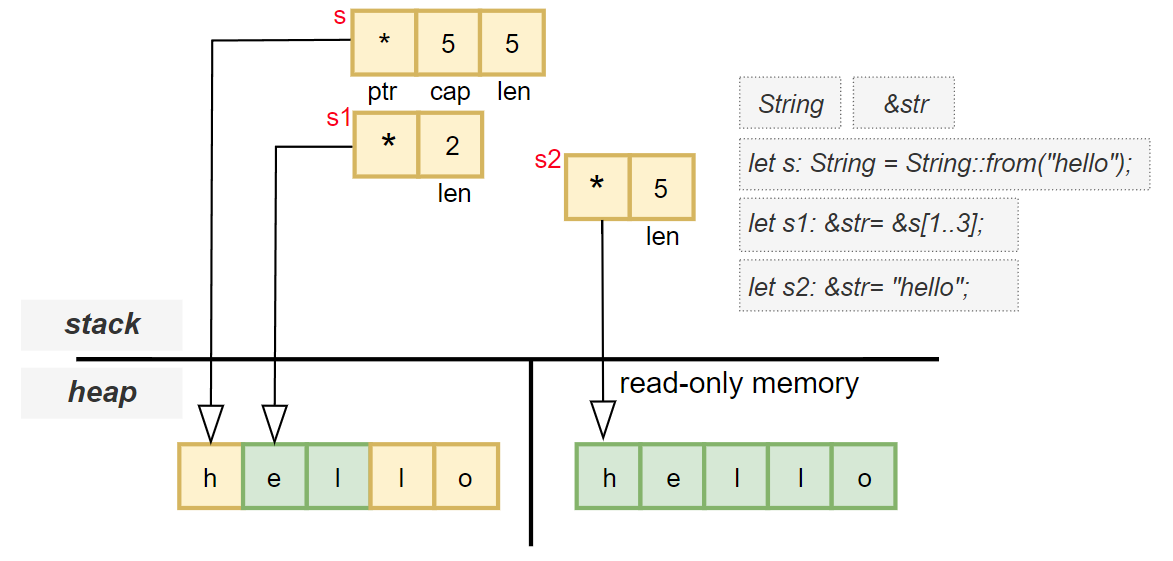
String – A Heap-Allocated String Type
A String is essentially a heap-allocated wrapper around a Vec<u8>, with additional guarantees that the bytes represent valid UTF-8 text.
Like a vector, a String stores three values on the stack:
| Field | Description |
|-------|-------------|
| `ptr` | Pointer to the start of the UTF-8 encoded string data on the heap |
| `len` | Length of the current string (in bytes) |
| `cap` | Total allocated capacity in bytes |
This makes String a flexible, growable container for text.
Example:
let s: String = String::from("hello");
This allocates "hello" on the heap and manages it via the String type on the stack.
&'static str – String Literals
When you assign a string literal directly to a variable:
let s2: &'static str = "hello";
The type of s2 is a string slice (&str) with a 'static lifetime. These literals are:
- Stored in the
.rodatasection of the binary (read-only data) - Immutable and embedded directly into the compiled code
The variable s2 is represented as a fat pointer, containing:
| Part | Description |
|------|-------------|
| `ptr` | Pointer to the location of `"hello"` in read-only memory |
| `len` | Length of the string (5 bytes in this case) |
You can get the raw pointer like this:
let ptr: *const u8 = s2.as_ptr();
🔒 Because these strings live in read-only memory, they are immutable and have a static lifetime.
str – The Primitive String Type
The str type in Rust is a dynamically sized type (DST). It represents a sequence of UTF-8 bytes but does not include length information in the type itself.
⚠️ You cannot declare a variable of type
strdirectly — because its size isn’t known at compile time.
Instead, you always use it behind a reference:
&str // This is the common form
Which gives you a fat pointer made up of:
- A pointer to the UTF-8 data (
*const u8) - The length of the string slice (
usize)
This makes &str safe to store on the stack and efficient to pass around.
Slicing Strings
Just like with arrays and vectors, you can create slices from a String:
let s1: &str = &s[1..3];
This returns a new slice referencing a portion of the original string.
📌 Important Notes:
- No data is copied — only a reference is created.
- The slice includes metadata about the length.
- Since
strhas no known size, you must use a reference when slicing.
Understanding the difference between String and &str is crucial for writing efficient and idiomatic Rust code.
Structs
In Rust, structs are custom data types that let you group together named values (or unnamed in some cases) to create meaningful abstractions.

There Are Three Main Types of Structs in Rust:
| Type | Description |
|-------------------|-------------|
| **Named-field struct** | Classic structs with fields that have both a name and a type. |
| **Tuple struct** | Structs without field names — behave like tuples with a custom type identity. |
| **Unit-like struct** | A struct with no fields — behaves like a **ZST (Zero-Sized Type)**. |
📌 Unit-like structs are often used for marker types or implementing traits without carrying any data.
Memory Layout of Named-Field Structs
A struct with named fields stores all its data inline, typically on the stack, assuming all of its fields can be placed there.
For example:
struct User {
name: String,
age: u32,
}
This struct contains:
- A
String— which itself is a stack-allocated pointer + length + capacity, pointing to heap data. - A
u32— a simple primitive stored directly on the stack.
These fields are laid out next to each other in memory, just like a tuple.
✅ So internally, a struct with named fields has a layout similar to a tuple struct — just with named accessors.
Heap Allocations Inside Structs
If a struct contains a type that uses heap memory (like Vec<T> or String), then:
- The metadata (pointer, length, capacity) lives on the stack
- The actual data resides on the heap
Example:
struct Data {
nums: Vec<i32>,
}
numsis aVec<i32>, so:- Its control block (
ptr,len,cap) lives on the stack insideData - The actual elements are stored on the heap
- Its control block (
🔄 This means structs themselves can be stack-only or indirectly reference heap data, depending on their contents.
Enums
Enums in Rust are a powerful way to represent data that can be one of several possible variants. They come in different forms and have nuanced memory layouts depending on their usage.
C-Style Enums
A basic enum with unit-like variants is stored internally as an integer, with each variant assigned a numeric tag starting from 0.
enum HTTPStatuses {
OK,
NotFound,
}
- This is known as a C-style enum.
- The compiler automatically chooses the smallest integer type that can fit all variant tags.
📌 In this case, only two variants exist (
0and1), so the enum can be represented using just 1 byte (u8).
Enums with Explicit Integer Values
You can also assign explicit integer values to enum variants:
enum HTTPStatuses {
OK = 200,
NotFound = 404,
}
In this case:
- The maximum value is
404, which requires at least 2 bytes (u16) to store. - Due to alignment and consistency, all variants will take up 2 bytes, even if some could fit into fewer.
🧠 This ensures uniform size across all variants — a key requirement for safe and predictable memory layout.
Enums with Payloads
Rust enums can also carry data, making them even more expressive.
enum Data {
Empty,
Number(i32),
Array(Vec<i32>),
}
Each variant may have a different internal structure, but:
✅ All variants must occupy the same amount of memory.
To achieve this, Rust uses the following strategy:
- It calculates the maximum size required by any variant (including space for metadata like pointer + length for
Vec<i32>). - Then it pads smaller variants to match this size.
- Each variant also includes an internal tag (like
0,1,2) to identify which variant is currently active.
This makes enums with payloads both safe and efficient, while still allowing complex data to be stored inline when possible.
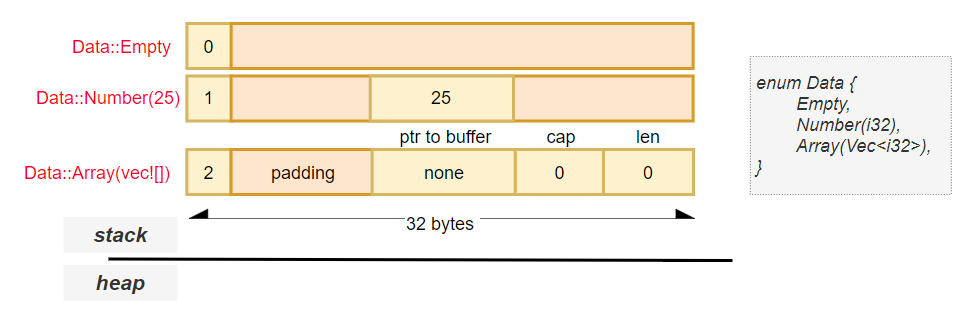
Enums with Box
In Rust, enums can become quite large in memory when they contain heavy variants — especially those that store heap-allocated types like Vec<T>.
One effective way to optimize the size of an enum is by wrapping large variants in a Box<T>, which stores the data on the heap and only keeps a pointer on the stack.
Example Without Box
enum Data {
Empty,
Number(i32),
Array(Vec<i32>),
}
In this case:
- The entire
Vec<i32>(which includesptr,len, andcap) must be stored inline within the enum. - This makes the entire enum take up as much space as its largest variant, even if you're currently using a small one like
EmptyorNumber.

Optimizing with Box
To reduce the overall size of the enum, we can box the vector:
enum Data {
Empty,
Number(i32),
Array(Box<Vec<i32>>),
}
Now:
- Instead of storing the full
Vec<i32>, theArrayvariant stores just a pointer (*const Vec<i32>) — which is a single machine word. - The actual vector data lives on the heap.
- As a result, the total size of the enum is significantly reduced — often cut in half or more, depending on the platform and variant sizes.
Memory Layout
Let’s break down what happens under the hood:
Stack:
- Stores the enum itself, including:
- An internal tag to identify the active variant
- For
Array, a pointer (ptr) to where the boxedVec<i32>is stored in heap memory
Heap:
- Contains the boxed
Vec<i32>- Inside it: another pointer (
ptr), length (len), and capacity (cap) - And finally, the actual
i32values stored in the vector
- Inside it: another pointer (
This creates a chain of indirection:
Stack → ptr → Heap (Box) → ptr → Heap (Vec) → ptr → Heap (data)
⚠️ While this adds a level of indirection, it significantly improves memory efficiency for large variants — making it a great trade-off in many cases.
Copy vs Move in Rust
Rust’s ownership system governs how data is copied or moved between variables. The behavior depends on whether the type is stored entirely on the stack (simple types) or involves heap allocation.
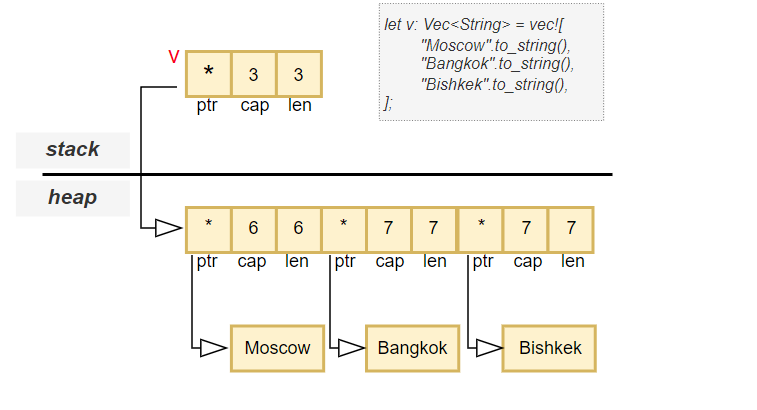
Stack-Only Types: Copy Semantics
For primitive types like i32, bool, char, and small fixed-size arrays:
- Assigning one variable to another performs a bitwise copy.
- Both variables now hold their own independent copies of the data.
- This is safe and efficient because all the data fits neatly on the stack.
let a = 42;
let b = a; // `a` is copied into `b`
✅ These types implement the
Copytrait, meaning they are duplicated automatically on assignment or function calls.
Heap-Allocated Types: Move Semantics
For types that involve heap allocation, such as Vec<T> or String, copying isn't automatic — for good reason.
Let’s take an example:
let v = vec![String::from("hello"), String::from("world")];
What’s Stored Where?
Each String inside the vector has this internal structure:
- A pointer (
ptr) to the actual UTF-8 bytes on the heap - A length (
len) - A capacity (
cap)
These three values (each of type usize) make up the string header, and are stored inline within the vector.
The vector itself also contains:
- A pointer to its heap-allocated memory block
- Its current length
- Its allocated capacity
So, on the stack, you get:
- A small control block (3
usize) representing the vector header
On the heap, you get:
- The vector’s array of string headers
- The actual UTF-8 byte sequences for each string, stored separately
Ownership Transfer with Move
When you assign a heap-allocated value to a new variable:
let v2 = v;
This results in a move, not a copy.
- The original variable (
v) is invalidated — it no longer owns the data. - The new variable (
v2) becomes the sole owner of the heap-allocated memory. - Internally, only the 3 machine words (pointer, length, capacity) are copied from
vtov2.
⚠️ No deep copy of the heap data occurs — both variables point to the same memory region.
At the end of the scope, when v2 goes out of scope, its drop() function is called, freeing the memory once and for all.
Deep Copy: When You Need a Full Clone
If you want two independent copies of the same data, you must explicitly request a deep copy using .clone():
let v2 = v.clone();
Now:
- A new block of memory is allocated on the heap
- All elements (including strings) are copied
- Each variable owns its own unique block of memory
📌 This ensures safety and clarity — if you want a full copy, you have to ask for it.
Shared Ownership with Rc<T>
In Rust, the ownership model ensures memory safety by enforcing strict rules about who owns and can modify data. But what if you want a value to have multiple owners?
That’s where Rc<T> — short for Reference Counted — comes in.
When to Use Rc<T>
You use Rc<T> when:
- You need multiple parts of your program to share read-only access to the same data.
- You want the data to be freed automatically when the last owner is done with it.
Unlike regular references (which are temporary), Rc<T> allows multiple strong references to the same data, and keeps the data alive as long as at least one reference exists.
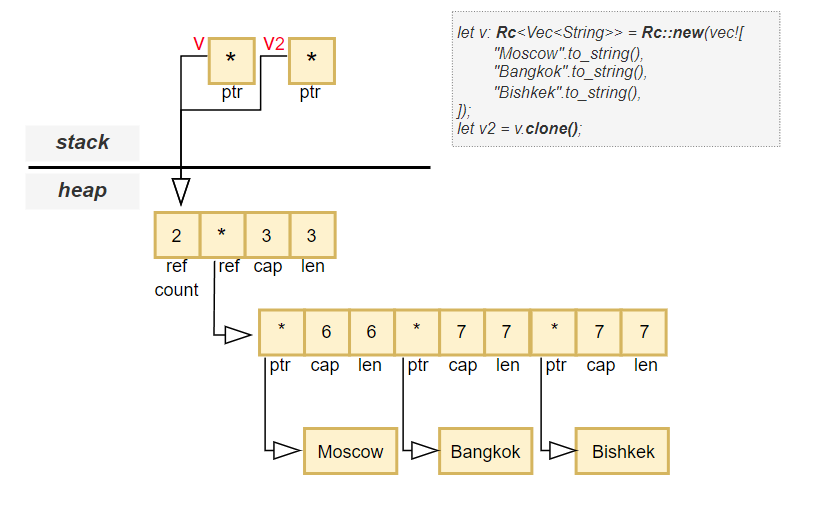
How Rc<T> Works
Let’s look at an example:
use std::rc::Rc;
let v: Rc<Vec<String>> = Rc::new(vec![
"Odin".to_string(),
"Thor".to_string(),
"Loki".to_string(),
]);
let v2 = v.clone();
Under the hood:
- The vector (and all its contents) is allocated on the heap.
- Alongside the vector's usual header (
ptr,len,cap),Rc<T>also allocates space for a reference count. - Each time you call
.clone()on anRc<T>, this counter is incremented. - When an
Rc<T>variable goes out of scope, the counter is decremented. - Only when the count reaches zero is the heap memory freed.
Memory Layout
On the Stack:
Each Rc<T> variable (like v and v2) stores just one thing:
- A single pointer (
usize) pointing to the shared data on the heap.
On the Heap:
The actual allocation contains:
- The inner value (e.g., a
Vec<String>) - A reference count
- Possibly alignment padding
This makes Rc<T> very efficient in terms of stack usage, while still managing complex heap allocations safely.
Immutable by Default
One important restriction:
🔒 Values inside an
Rc<T>are immutable by default.
If you try to mutate the inner value, you’ll get a compile-time error unless you use interior mutability patterns like RefCell or Mutex.
Thread Safety: Send and Sync
In Rust, concurrency is handled with strong compile-time guarantees to prevent data races. Two important traits that enable this are:
SendSync
These traits are used by the compiler to determine whether a type can be safely shared or transferred between threads.
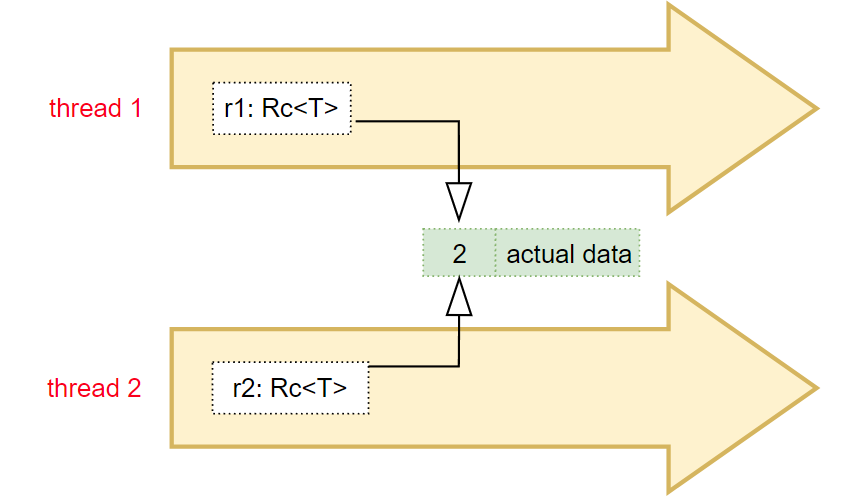
Send – Safe to Transfer Ownership Across Threads
A type that implements Send indicates that:
✅ It is safe to move its value from one thread to another.
More precisely:
T: Sendmeans ownership ofTcan be transferred across thread boundaries.- This includes types passed into closures given to
thread::spawn.
Example:
use std::thread;
let data = vec![1, 2, 3];
thread::spawn(move || {
println!("{:?}", data);
}).join().unwrap();
This compiles only because Vec<T> (and thus data) implements Send.
Sync – Safe to Share References Across Threads
A type that implements Sync indicates that:
✅ It is safe to share immutable references (
&T) between threads.
In other words:
T: Syncmeans it’s safe for multiple threads to have access to the same&T.- This ensures no data races occur when reading through shared references.
Example:
use std::sync::Arc;
use std::thread;
let data = Arc::new(vec![1, 2, 3]);
let data_clone = Arc::clone(&data);
thread::spawn(move || {
println!("From thread: {:?}", data_clone);
}).join().unwrap();
This works because Arc<Vec<i32>> is both Send and Sync.
Relationship Between Send and Sync
| Trait | Meaning | Implies |
|-------|---------|---------|
| `Send` | Safe to transfer ownership to another thread | `T` can be moved between threads |
| `Sync` | Safe to share immutable references between threads | `&T` can be sent between threads |
Also:
- If
TisSync, then&TisSend. - Most primitive types like
i32,bool, and pointers like&'static strare bothSendandSync.
Why Rc Is Not Send or Sync
The Rc<T> type is not thread-safe, and therefore does not implement Send or Sync.
Why?
Because:
Rc<T>maintains a reference count in shared memory.- If two threads each hold an
Rc<T>pointing to the same value and try to clone or drop at the same time, this can lead to a data race on the reference count.
Example:
use std::rc::Rc;
use std::thread;
let counter = Rc::new(0);
let counter_clone = Rc::clone(&counter);
thread::spawn(move || {
// ❌ Compile error! `Rc` is not `Send`
let _ = counter_clone;
}).join().unwrap();
To safely share reference-counted values between threads, use Arc<T> instead — the Atomic Reference Counted pointer, which is thread-safe and implements both Send and Sync.
Summary
-
Primitive types (
i32,bool, etc.):Send: YesSync: Yes- Thread-safe: Yes
-
Vec<T>,String:Send: YesSync: Yes- Thread-safe: Yes
-
&T(ifT: Sync):Send: YesSync: Not applicable (references themselves are notSync)- Thread-safe: Yes
-
Rc<T>:Send: NoSync: No- Thread-safe: No
-
Arc<T>:Send: YesSync: Yes- Thread-safe: Yes
-
RefCell<T>/Cell<T>:Send: NoSync: No- Thread-safe: No
-
Mutex<T>:Send: Yes (ifT: Send)Sync: Yes (ifT: Sync)- Thread-safe: Yes
Thread-Safe Shared Ownership with Arc<T>
When you need to share data between threads, Rust provides a thread-safe version of Rc<T> called Arc<T> — short for Atomic Reference Counted.
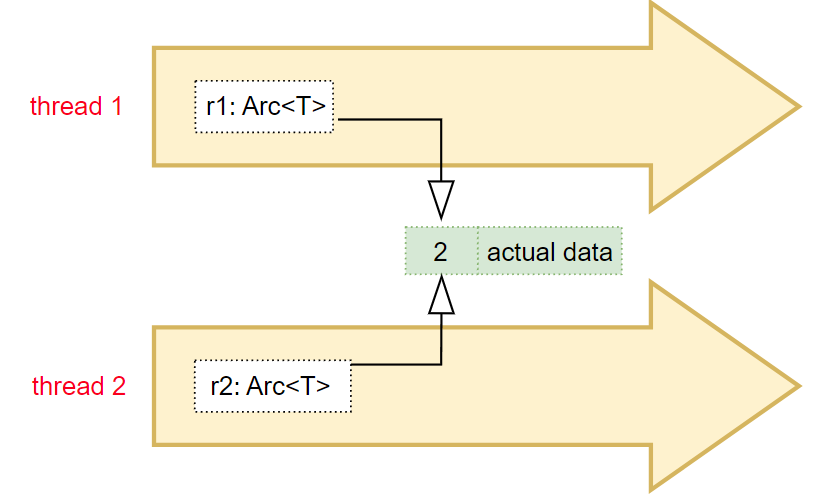
When to Use Arc<T>
Use Arc<T> when:
- You want multiple threads to safely share ownership of a value.
- The reference count needs to be updated concurrently without data races.
It works similarly to Rc<T>, but with one crucial difference:
🔐 The reference count is modified using atomic operations, making it safe to use across threads.
How Arc<T> Works
Like Rc<T>, each time you call .clone() on an Arc<T>:
- The internal reference count is atomically incremented.
- When a clone goes out of scope, the count is atomically decremented.
- Once the count reaches zero, the value is safely deallocated.
This ensures that even in a multi-threaded context, memory is managed correctly and safely.
Performance Trade-off
Because atomic operations are involved:
⚠️
Arc<T>has a small performance cost compared toRc<T>.
This overhead comes from ensuring thread safety during reference counting. However, in most cases, this cost is negligible compared to the benefits of safe concurrency.
Immutability by Default
Just like Rc<T>, values inside an Arc<T> are immutable by default.
Even though multiple threads may hold a reference to the same data:
🚫 They cannot modify the value unless combined with interior mutability types like
Mutex<T>orRwLock<T>.
Example:
use std::sync::{Arc, Mutex};
use std::thread;
let data = Arc::new(Mutex::new(0));
let data_clone = Arc::clone(&data);
thread::spawn(move || {
let mut num = data_clone.lock().unwrap();
*num += 1;
}).join().unwrap();
println!("Data: {}", *data.lock().unwrap()); // Output: Data: 1
In this example:
Arcenables shared ownership across threads.Mutexensures safe, exclusive access to the inner value for mutation.
